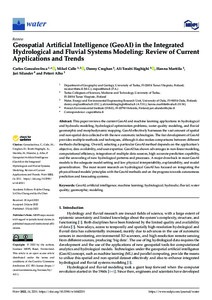Geospatial Artificial Intelligence (GeoAI) in the Integrated Hydrological and Fluvial Systems Modeling: Review of Current Applications and Trends
Croghan Danny; Calle Mikel; Haghighi Ali Torabi; Gonzales-Inca Carlos; Marttila Hannu; Silander Jari; Alho Petteri
Geospatial Artificial Intelligence (GeoAI) in the Integrated Hydrological and Fluvial Systems Modeling: Review of Current Applications and Trends
Croghan Danny
Calle Mikel
Haghighi Ali Torabi
Gonzales-Inca Carlos
Marttila Hannu
Silander Jari
Alho Petteri
MDPI
Julkaisun pysyvä osoite on:
https://urn.fi/URN:NBN:fi-fe2022091258823
https://urn.fi/URN:NBN:fi-fe2022091258823
Tiivistelmä
This paper reviews the current GeoAI and machine learning applications in hydrological and hydraulic modeling, hydrological optimization problems, water quality modeling, and fluvial geomorphic and morphodynamic mapping. GeoAI effectively harnesses the vast amount of spatial and non-spatial data collected with the new automatic technologies. The fast development of GeoAI provides multiple methods and techniques, although it also makes comparisons between different methods challenging. Overall, selecting a particular GeoAI method depends on the application's objective, data availability, and user expertise. GeoAI has shown advantages in non-linear modeling, computational efficiency, integration of multiple data sources, high accurate prediction capability, and the unraveling of new hydrological patterns and processes. A major drawback in most GeoAI models is the adequate model setting and low physical interpretability, explainability, and model generalization. The most recent research on hydrological GeoAI has focused on integrating the physical-based models' principles with the GeoAI methods and on the progress towards autonomous prediction and forecasting systems.
Kokoelmat
- Rinnakkaistallenteet [19207]
